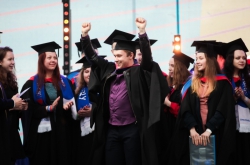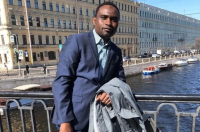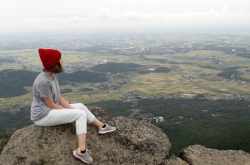Alexei Slobojanuk, Australian National University
Completing a PhD program is a must if you’re planning to become a scientist and focus on conducting research; in a sense, it becomes the boundary you have to cross to call yourself a scientist. After getting my Bachelor’s degree, I decided that I need to broaden my horizons, so I set the goal of entering a joint PhD program with the Australian National University - a leading international center in the field of science I focus on. It was for that reason that me and my research advisor Pavel Belov decided that I should go to Australia to work under Yuri Kivshar, professor at the Australian National University and co-head of ITMO’s Center for Nanophotonics and Metamaterials. Upon completing my Bachelor’s and Master’s programs at ITMO University, I already had some considerable scientific background, but we thought that to make the most of it, I had to receive some experience working with a different research team. To have a look at how they do science abroad and bring this experience back home was very important to me.
In order to join the desired PhD program, I had to complete several preliminary tasks, i.e. pass the entrance examinations, find a scholarship that would cover my tuition fees and accommodation, and pass the IELTS Exam. I applied for my PhD program right after I got my Bachelor’s degree (one can do that at Australian and British universities); the only condition to doing so is having sufficient scientific groundwork which has to be reflected in the student’s resume. Also, having recommendations from renowned scientists gives one a considerable advantage, as well.
 Alexei Slobojanuk
Alexei Slobojanuk
I succeeded in getting such recommendations, and by the time I finished the first term of my Master’s program at ITMO, I received the acceptance letter. After the second term, I went to Australia and soon returned to Russia to make arrangements for completing the second year of my Master’s program remotely. There weren’t any problems with that, as the second year of a Master’s program is mostly about doing research, and that was exactly what I went to Australia for.
My PhD program lasted from June 2014 till December 2017; I spent about 60% of this time in Australia and the rest - in Russia, when I returned to ITMO University to conduct most of the experiments that I included in my thesis. After I finished it, my research was sent to three independent international specialists who read it and gave their comments. When one participates in a joint program, the universities sign an agreement where they state where and in which language the student defends their thesis. I had my thesis defence in Australia; in Russia, I only presented my research at my department and as part of several conferences.
My thesis was dedicated to controlling near electromagnetic fields by using new artificial metamaterial structures. These allow to control electromagnetic fields on a subwave level - a much lesser scale than that of a wavelength. This allows to create new devices; for instance, a part of my research had to do with a new field of topological photonics, where scientists develop unique waveguides that allow to control the propagation of light without absorption or dispersion induced by defects. The other part of my work was about creating devices for improving the quality of magnetic resonance imaging. In this case, we use new structures to control the near field so as to improve the spatial resolution of MR images and accelerate the process with no loss in quality. This research laid the groundwork of an innovative platform for developing personalized medicine and high-efficiency diagnostic equipment in Russia.
 Australian National University. Credit: obnovastroym.ru
Australian National University. Credit: obnovastroym.ru
I know for a fact that by having a lengthy experience of studying and working abroad at leading international universities (completing a PhD program, in my case), one becomes a more sought-after specialist. For just anyone who has decided to do science, going abroad is a very important stage of their careers, as it is the time when they get new knowledge and experience that they can bring back. Our country has a long-standing history of developing science, but it hasn’t been long since science started to get stable financing. In many foreign countries, they have it different, which is why they’ve succeeded in creating a better environment for conducting research. This is why internships and joint programs present great opportunities to learn from their experience and bring back their best practices, especially if those are the practices of leading universities and research teams.
Vanik Shahnazaryan, University of Iceland
I made the decision to devote myself to physics during the third year of my Bachelor’s program. At that time, I was studying at the Faculty of Physics and Technology of the Russian-Armenian University, majoring in microtronics. Around that time, I noticed that I am more interested in studying the science behind the phenomena that emerge in different semiconductor structures than in their application in microelectronic devices. As the level of scientific research of these phenomena in the Western countries is considerably higher than that in the post-Soviet states, it was from the very beginning of my career that I decided to aim for a PhD program at some leading Western university.
In my case, the agreement on a joint educational program between the two universities was concluded when I was already studying abroad. Thus, my PhD program at the University of Iceland transformed into a joint educational program with ITMO University. By the start of my second year in Iceland, my research advisor Ivan Shelykh was offered a position as head of an international laboratory at ITMO’s Department of Nanophotonics and Metamaterials. So, I was offered a joint PhD program at both universities, which allowed me to better integrate into Russia’s scientific community and contributed to the continuation of my research career in Russia.
 Vanik Shahnazaryan
Vanik Shahnazaryan
I did research at the University of Iceland from 2014 till 2017; there, I studied optical and electronic properties of low-dimensional semiconductor structures in strong light - matter coupling regime. As of today, this subject is an actively developing cross-disciplinary field of physics which has a high potential in regard to its application in new generation optoelectronic devices.
In Iceland, their approach to research and especially the training of PhD students has a lot less bureaucracy and formalities to it. For instance, they don’t burden the PhD students with the subjects that don’t have much to do with their research fields (like philosophy, psychology, bibliography and the like). Thus, the students can dedicate a lot more time and effort to real research, which contributes to attaining better results. Also, they are quick to put forward financing for trips to conferences and similar things.
I defended my thesis in Iceland, and then had my diploma verified in Russia. To my mind, the process of thesis defense in Iceland is much simpler than in Russia. In essence, the decision is made by the faculty’s academic board, that includes one’s research advisor and the professors who recommend students for thesis defense based on their scientific experience and competencies only. Also, the research advisor puts forward the candidates for opponency who are then approved by the academic board. The thesis defense is conducted publicly, and involves the candidate’s report and a scientific discussion with opponents.
I believe that one must definitely take the chance to participate in a joint program if there is one. Apart from everything I’ve already shared about, it is also a great opportunity to discover a new country and culture, find new friends and useful connections. Participation in a joint educational program can become a most exciting adventure you will never regret participating in!
Sergei Kosulnikov, Aalto University (Finland)
In 2013, as I was finishing my Master’s program, I understood two things. First, I knew that I liked what I studied. Second, I still wasn’t good enough at it. But, it is well known that you can always learn more, especially while doing research. I won’t say that at that time, I saw my future self as an efficient research officer with a PhD; truth be told, even now I don’t have a clear vision of my future. Still, I am happy that I’ve received the experience of studying at a foreign educational establishment, and I am very thankful to ITMO University for giving me such an opportunity.
 Sergei Kosulnikov
Sergei Kosulnikov
Five years ago, I graduated from one of ITMO’s most successful departments - the Department of Photonics and Optical Information Technology. Yet, starting with 2008 when I was still a Bachelor’s student, I’ve been doing research work under Pavel Belov, head of the new Metamaterials laboratory. It was he who offered me to enter an educational program under joint academic advising at a foreign university. What is more, my scientific advisor at Aalto University was Konstantin Simovski, once research advisor of Pavel Belov, so I had no doubts considering the high level of education I’ll be getting in Finland. Just before my departure, some serious changes happened to the structures I were to do my PhD program at. The laboratory became a full-fledged Faculty with numerous subdivisions, and I became part of it. Still, I never forgot the time I spent at Sergei Kozlov’s Faculty of Photonics and Optical Information. Several times during the years of my PhD program, I came back there to tell about my achievements and even participated in a “strategic session” of the new Faculty where I shared the ideas and experience I got at Aalto University so as to help organize a more effective and comfortable working environment. Each time, I met new people and learned about the novelties introduced by this St. Petersburg team.
In Finland, I studied at Aalto University which is located in the town of Espoo near Helsinki. The research team I was part of is supervised by two professors - Sergei Tretyakov and Konstantin Simovski. Usually, completing a PhD program takes 4 years, sometimes this term can be extended. In my case, it was all different, as I entered my PhD program at ITMO University in 2013, when the former Education Act was still in force; so I had to graduate before the end of 2017 from both universities. Thus, my PhD program in Finland took 3.5 years, from June 2014 till December 2017. The topic of my thesis was “Wire media for broadband enhancement of radiation and power transfer”; initially, it implied studying the effects of amplifying heat emission, then its focus shifted to the fundamental effects of transformation of electromagnetic waves in a metamaterial based on wire media. Metamaterials are a research focus for both Aalto University and ITMO; both institutions actively collaborate in this field. The result of my research can be applied in devices that call for an ultrafast extraction of thermal radiation (nanolasers, for instance), and other similar applications. Apart from the general research that served as basis for my thesis, I participated in other projects by both research teams. As for the difference in approach to education and research, I would say that it mostly has to do with planning - in Finland, the results seem to be better, as they perceive the available time and capabilities more adequately. Yet, it wasn’t hard for me to settle in Finland, partly due to the number of Russian-speaking colleagues I had, as well as frequent communication with my research team at ITMO.
 Aalto University. Credit: ufisa.aalto.fi
Aalto University. Credit: ufisa.aalto.fi
I defended my thesis at Aalto University. After getting my diploma, I had to send it to ITMO University so as to start the procedure of approving the diploma in Russia. After I wrote my thesis, it had to pass two stages of reviewing. First of all, it had to be approved by Aalto University’s Doctoral Committee, and then they sent it to two independent experts (in my case, those were two professors, one from Belgium and another - from Great Britain). After getting positive reviews, the Doctoral Committee approves one or two opponents that are usually proposed by the research advisor, and schedules the date of public defense. Usually, the defense is conducted a year or half a year after the articles the thesis is based upon are published. As for the thesis defense process, it also follows a strict procedure. For instance, they have detailed rules for entering the room, the suitable dress code and even certain phrases that one absolutely has to use. The breach of the procedure can be seen as grounds for revoking the defense’s results. There are no strict regulations for the opponent’s questions only - albeit the recommendation that one’s defense must not take longer than four hours. There are known cases when a defense lasted for more than ten; still, I witnessed instances when the opponents were satisfied with just a half-an-hour discussion. After the opponents announce their decision, anyone present in the room can take the floor and ask questions, or even question the candidate’s and opponents’ statements. So, I would say that the process of defending a thesis in Finland differs from what I’ve seen in Russia.
I can safely say that getting my PhD as part of a joint educational program has been a huge step forward for me - the knowledge and experience I got during these years were totally priceless, and I’m not just talking about professional experience only, but personal experience, as well. I learned about living in a different country, made new friends from all over the world, got to participate in various conferences, got new skills and went through many challenges - from passing due examinations and presenting reports to keeping my cool during the announcement of contest results. Fortunately, it all ended well for me, and that gave me confidence in myself and my future. This is why I would recommend anyone who’s fond of new challenges and pursuing self-fulfillment to try a joint educational program, more so that ITMO University offers all the necessary opportunities to do so.







